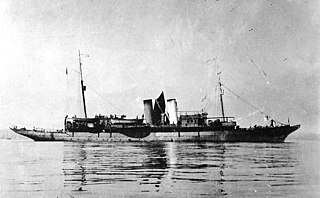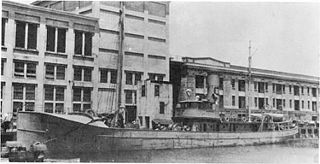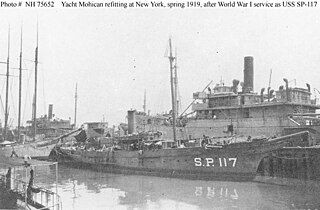
USS Drayton (DD-23) was a Paulding-class destroyer in the United States Navy. She was the first ship named for Captain Percival Drayton.

USS Alcedo (SP-166) was a yacht in the United States Navy. She was the first American vessel lost in World War I.

USS Isabel (SP-521), later PY-10, was a yacht in commission in the United States Navy as a destroyer from 1917 to 1920 and as a patrol yacht from 1921 to 1946.

USS Cythera (SP-575/PY-26) was a US Navy patrol yacht, originally laid down as the civilian yacht Agawa for William L. Harkness, that saw service in the Atlantic during both World War I and World War II.

USS Oceanographer (AGS-3) was a survey ship of the United States Navy during World War II that produced charts chiefly of passages in the Solomon Islands area of the Pacific Ocean. Upon transfer to the Navy, she had initially briefly been named and classed as gunboat USS Natchez (PG-85). Before her World War II Navy service, she had been USC&GS Oceanographer (OSS-26), a survey ship with the U.S. Coast and Geodetic Survey from 1930.

USS Kanawha II (SP-130)/USS Piqua (SP-130) -- was a yacht acquired by the U.S. Navy during World War II. She was placed into service as an escort for Allied convoys traveling across the dangerous North Atlantic Ocean. German U-boats were active in sinking Allied ships, and Kanawha II provided a valuable service as a lookout and in one instance attacked one and drove it off. Post-war she was returned to her pre-war owner in July 1919.

The first USS Vedette (SP-163) was a commercial yacht built in 1899. At the outbreak of World War I, the yacht was leased by the United States Navy, and was used as a section patrol craft in the North Atlantic Ocean. She served honorably during the war, rescuing survivors at sea, and attacking a German U-boat. At war’s end, she was converted to her original configuration and returned to her owner, the railroad executive, financier, and philanthropist Frederick W. Vanderbilt (1856-1938) of New York City.

USS Sultana (SP-134) was a yacht acquired under a free lease by the U.S. Navy during World War I. She was outfitted as a patrol craft and was assigned to escort duty in the North Atlantic Ocean. She served honorably—rescuing survivors adrift in the water and protecting cargo ships from submarine attack—and was returned to her owner at the close of the war.

USS Noma (SP-131) was the private steam yacht Noma, built in 1902 on Staten Island and loaned to the U.S. Navy during World War I as a patrol craft assigned to protect shipping from German submarines. At war’s end she served the American Relief Commission in Constantinople and the Black Sea before being returned to her owner after decommissioning. In the 1930s she was converted to a salvage tug, owned in Italy as Salvatore Primo, and torpedoed during World War II.

USS Emeline (SP-175) was a yacht acquired by the U.S. Navy during World War I. She was outfitted with military equipment, including 3-inch guns, and was commissioned as a patrol craft, assigned to protect shipping in the North Atlantic Ocean. She saved the lives of survivors of shipwrecks, and provided escort protection from German submarines for commercial ships. Post-war she was sold to the highest bidder, who had the yacht sail to San Diego, California, for delivery.

USS Corona (SP-813) was a yacht acquired by the U.S. Navy during World War I. She was outfitted as a patrol craft, and assigned to the North Atlantic Ocean, based out of Brest, France, to protect shipping from the German submarines and Q-ships. Post-war she was decommissioned, returned to her original condition, and disposed of by public auction.

USS Utowana (SP-951) – also known as USS Victorine (SP-951) -- was a fishing trawler acquired by the U.S. Navy during World War I. The Navy had planned to use her as a minesweeper based out of Kittery, Maine; however, Utowana spent most of her service time operating as an armed patrol craft, responsible for escorting Allied ships across the dangerous North Atlantic Ocean. She served through the war and the armistice before returning to the United States for decommissioning.

USS Anderton (SP-530), originally to have been USS Raymond J. Anderton (SP-530), was a patrol vessel and minesweeper that served in the United States Navy from 1917 to 1919.

The third USS Wanderer (SP-132), was an armed yacht that served in the United States Navy from 1917 to 1919.

USS Munsomo (ID-1607) was a cargo ship that served in the United States Navy from 1918 to 1919.

The third USS Mohican (SP-117), later USS SP-117, was an armed yacht that served in the United States Navy as a patrol vessel from 1917 to 1919.

Aphrodite was a yacht built to requirements by owner Colonel Oliver H. Payne of New York City as an ocean going steam yacht with barque rig and capable of good speed under sail alone. The yacht was launched 1 December 1898 and completed in 1899 to be the largest American built steam yacht at the time. The yacht served in the United States Navy as the patrol vessel USS Aphrodite from May 1917 to July 1919. The yacht was given the designation SP-135 for Section patrol and was, unlike the majority of section patrol vessels, sent overseas rather than acting in that capacity in home waters. The yacht was returned to private service after the war.

USS Dreadnaught (ID-1951), later YT-534 and YNG-21, was a United States Navy tug that was in service from 1918 to 1944.

The second USS Calumet (SP-723) was a United States Navy patrol vessel in commission from 1917 to 1919.

USS Venetia (SP-431) was a large 589 gross ton steam yacht leased by the U.S. Navy during World War I. She was heavily armed with four 3-inch (76 mm) guns and depth charges, and was assigned duties of a patrol craft, escorting ships in convoy on the North Atlantic Ocean, and protecting those ships from German submarine attack. Venetia was awarded a "star of reward" for her antisubmarine work, and mounted the star on her stack. Post-war she was restored to her original civilian configuration, and was returned to her owner.




















